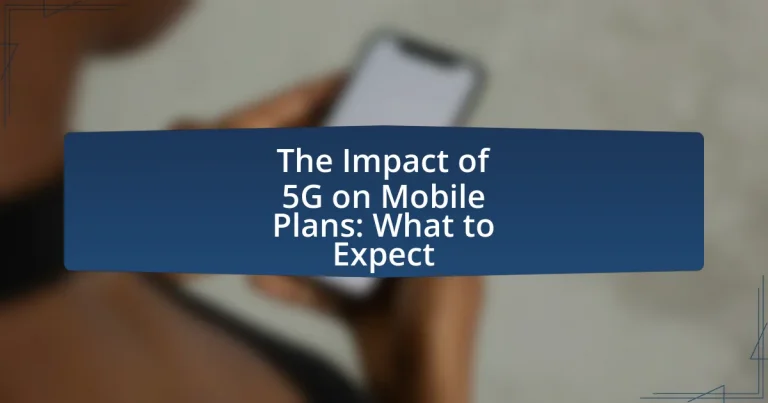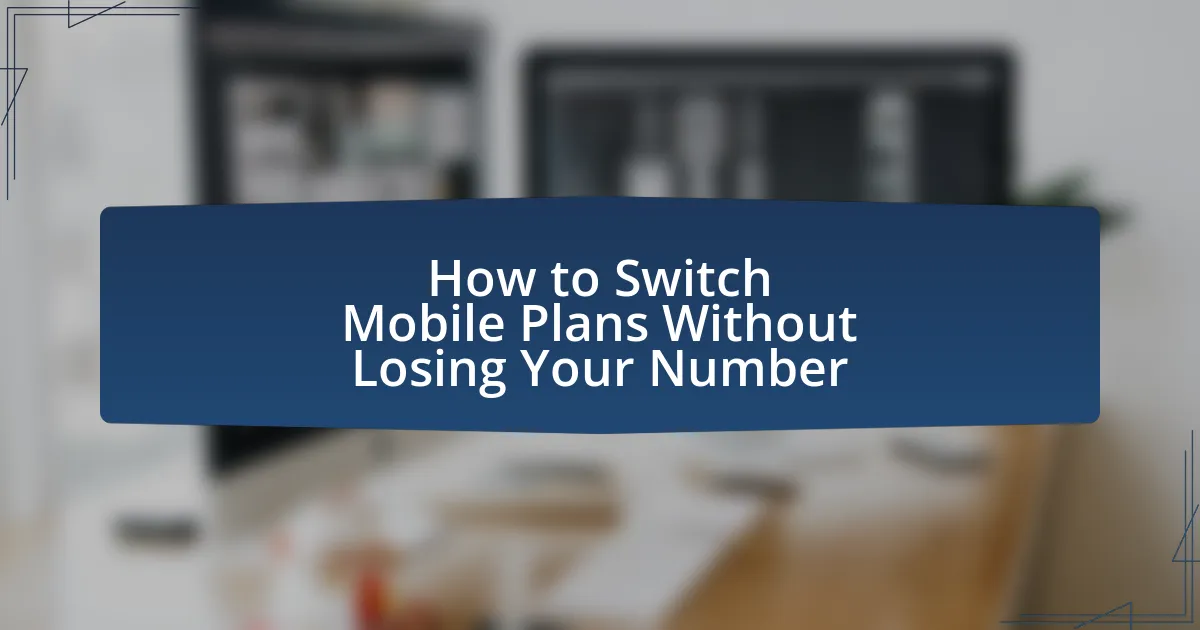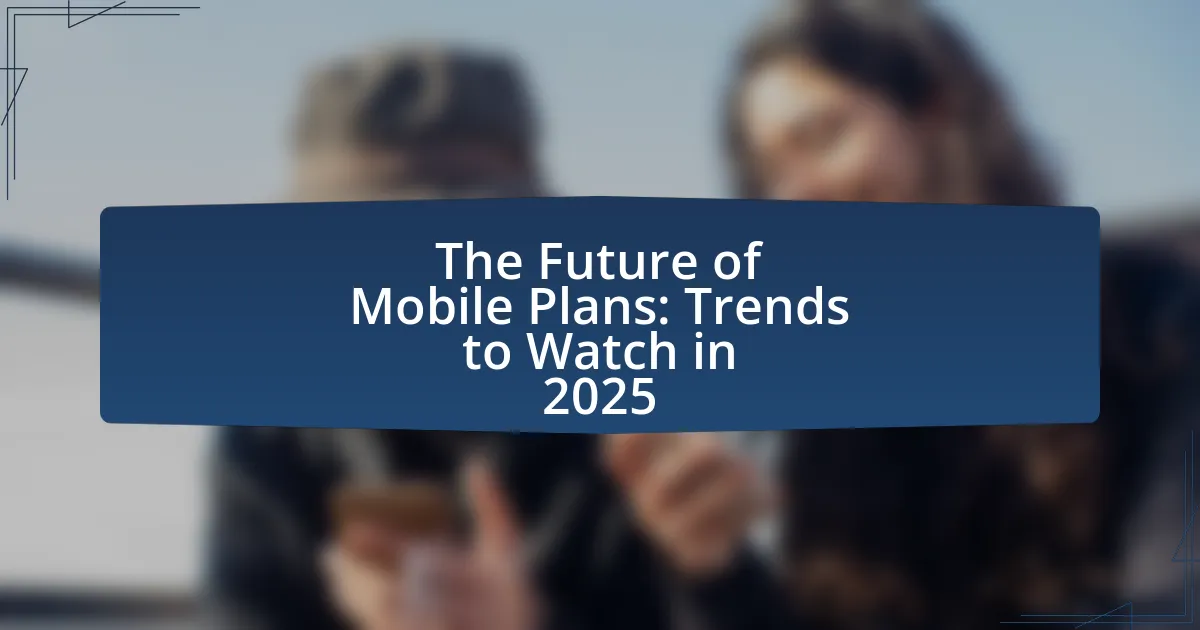The article focuses on the impact of 5G technology on mobile plans, highlighting significant advancements such as increased data speeds, lower latency, and enhanced network capacity. It discusses how mobile carriers are adapting their pricing structures and data allowances to accommodate the capabilities of 5G, including the potential for unlimited data plans and bundled services. Key features of 5G, including its ability to support a higher density of connected devices and improved user experiences in applications like streaming and gaming, are examined. Additionally, the article addresses the competitive landscape among carriers, the challenges of 5G implementation, and considerations for consumers when selecting mobile plans in the evolving 5G environment.
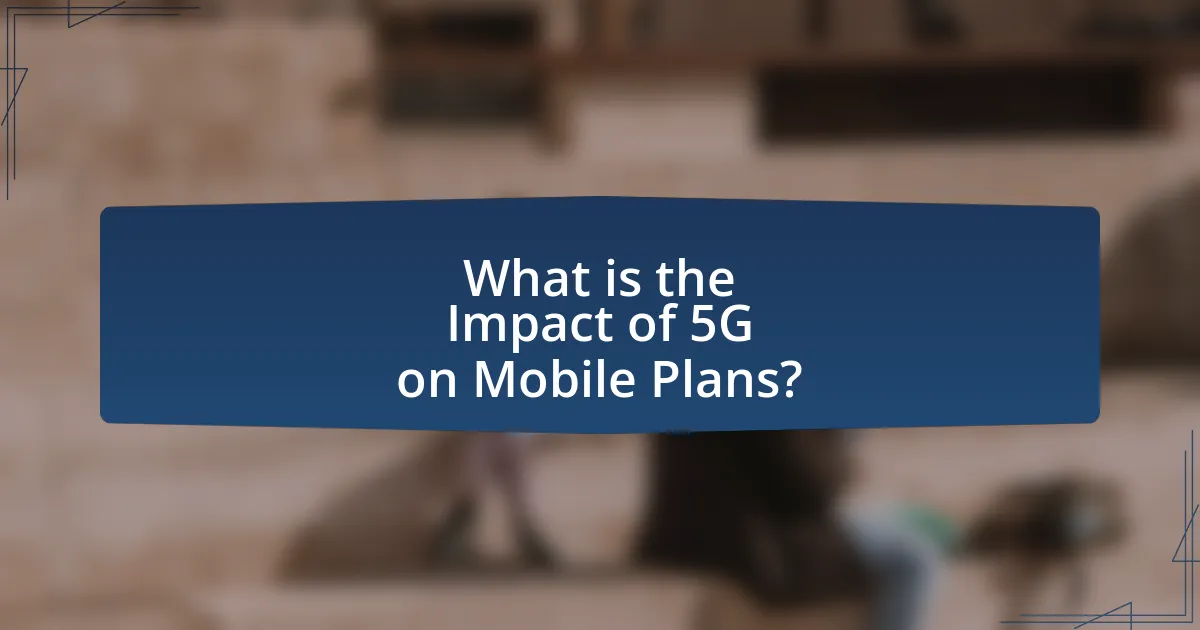
What is the Impact of 5G on Mobile Plans?
The impact of 5G on mobile plans includes increased data speeds, lower latency, and enhanced network capacity. Mobile carriers are adapting their plans to accommodate the higher performance capabilities of 5G technology, often resulting in higher data limits and new pricing structures. For instance, a report from the GSMA indicates that 5G networks can deliver speeds up to 100 times faster than 4G, prompting carriers to offer unlimited data plans to leverage this capability. Additionally, the introduction of 5G has led to the bundling of services, such as streaming subscriptions, to attract customers seeking enhanced mobile experiences.
How does 5G technology differ from previous generations?
5G technology differs from previous generations primarily in its speed, capacity, and latency. While 4G networks offer speeds up to 1 Gbps, 5G can achieve speeds exceeding 10 Gbps, enabling faster downloads and improved streaming experiences. Additionally, 5G supports a significantly higher number of connected devices per square kilometer—up to 1 million compared to 100,000 for 4G—allowing for the expansion of the Internet of Things (IoT). Furthermore, 5G reduces latency to as low as 1 millisecond, compared to 30-50 milliseconds for 4G, which enhances real-time communication and applications such as autonomous vehicles and remote surgery. These advancements position 5G as a transformative technology for mobile plans and connectivity.
What are the key features of 5G technology?
The key features of 5G technology include enhanced data speeds, reduced latency, increased capacity, and improved connectivity for a larger number of devices. Enhanced data speeds can reach up to 10 Gbps, significantly faster than 4G, allowing for quicker downloads and smoother streaming. Reduced latency, often as low as 1 millisecond, enables real-time communication, which is crucial for applications like autonomous driving and remote surgery. Increased capacity allows networks to support more devices simultaneously, addressing the growing demand for connectivity in urban areas. Improved connectivity facilitates the Internet of Things (IoT), enabling smart devices to communicate more efficiently. These features collectively enhance user experience and open new possibilities for various industries.
How does 5G enhance mobile connectivity?
5G enhances mobile connectivity by significantly increasing data transfer speeds, reducing latency, and enabling a higher density of connected devices. Specifically, 5G networks can achieve speeds up to 10 Gbps, which is up to 100 times faster than 4G, allowing for seamless streaming and faster downloads. Additionally, 5G reduces latency to as low as 1 millisecond, improving real-time communication and responsiveness in applications like gaming and virtual reality. Furthermore, 5G technology supports up to 1 million devices per square kilometer, facilitating the growth of the Internet of Things (IoT) and smart city applications. These advancements collectively transform user experiences and expand the capabilities of mobile connectivity.
What changes can consumers expect in mobile plans with 5G?
Consumers can expect enhanced data speeds, increased data allowances, and potentially higher costs in mobile plans with 5G. The introduction of 5G technology allows for download speeds that can exceed 1 Gbps, significantly faster than 4G, which enhances streaming, gaming, and overall mobile experience. Additionally, mobile plans may offer larger data packages to accommodate the higher data consumption associated with 5G services. However, as network providers invest in infrastructure, some consumers might face increased prices for these advanced services, reflecting the costs of deploying 5G technology.
How will pricing structures evolve with the introduction of 5G?
Pricing structures will likely become more competitive and diversified with the introduction of 5G. As telecom companies roll out 5G networks, they will need to attract customers by offering various pricing tiers that reflect the enhanced capabilities of 5G, such as faster speeds and lower latency. For instance, research from the GSMA indicates that 5G could lead to a 20% increase in mobile service revenues by 2025, prompting providers to create more flexible plans that cater to different user needs, including data-heavy applications like streaming and gaming. Additionally, promotional offers and bundled services may become more common as companies seek to differentiate themselves in a rapidly evolving market.
What new data limits or allowances might be introduced?
New data limits or allowances that might be introduced with the rollout of 5G technology include higher data caps and potentially unlimited data plans. As mobile carriers upgrade their infrastructure to support 5G, they are likely to offer plans that accommodate the increased data speeds and usage associated with high-definition streaming, gaming, and IoT devices. For instance, some carriers have already begun to implement plans with 50GB to 100GB data limits, reflecting the anticipated demand for more data-intensive applications. Additionally, the competitive landscape among providers may lead to more flexible data allowances, such as rollover data or family plans with shared data pools, to attract customers in a rapidly evolving market.
What are the potential benefits of 5G for mobile users?
The potential benefits of 5G for mobile users include significantly faster data speeds, lower latency, and enhanced connectivity. 5G technology can deliver download speeds up to 10 Gbps, which is up to 100 times faster than 4G, enabling quicker access to content and applications. Additionally, 5G reduces latency to as low as 1 millisecond, improving real-time communication and responsiveness for applications like gaming and video conferencing. Furthermore, 5G supports a higher density of connected devices, allowing for better performance in crowded areas, which is crucial as the number of IoT devices continues to grow. These advancements collectively enhance the overall mobile user experience, making it more efficient and seamless.
How will 5G improve user experience in mobile applications?
5G will significantly enhance user experience in mobile applications by providing faster data speeds, lower latency, and improved connectivity. With data speeds reaching up to 10 Gbps, users can download large files and stream high-definition content almost instantaneously. The latency reduction to as low as 1 millisecond enables real-time interactions in applications such as gaming and video conferencing, making experiences smoother and more responsive. Additionally, 5G’s ability to connect a greater number of devices simultaneously improves overall network reliability, allowing users to access applications without interruptions, even in crowded areas. These advancements collectively lead to a more efficient and enjoyable mobile application experience.
What advantages does 5G offer for streaming and gaming?
5G offers significantly enhanced speed, reduced latency, and increased capacity for streaming and gaming. The technology can deliver download speeds exceeding 1 Gbps, which allows for high-definition content to be streamed seamlessly without buffering. Additionally, 5G reduces latency to as low as 1 millisecond, enabling real-time interactions in gaming, which is crucial for competitive play. Furthermore, 5G networks can support a higher number of connected devices simultaneously, ensuring that multiple users can stream or game without degradation in performance. These advantages collectively enhance the overall user experience in both streaming and gaming environments.
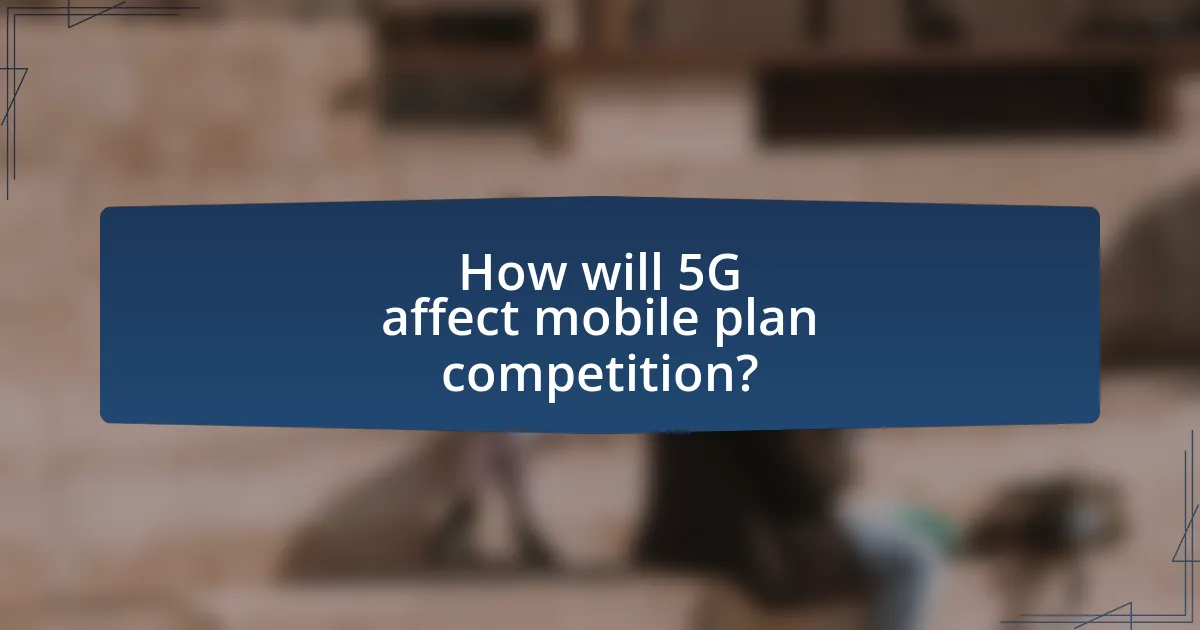
How will 5G affect mobile plan competition?
5G will intensify mobile plan competition by enabling faster data speeds and lower latency, prompting carriers to innovate and differentiate their offerings. As 5G technology rolls out, consumers will demand more data and better service quality, leading providers to enhance their plans with increased data allowances, bundled services, and competitive pricing. For instance, a report by the GSMA indicates that 5G could generate $2.2 trillion in economic impact by 2030, driving carriers to invest in more attractive mobile plans to capture market share. This competitive landscape will likely result in improved customer experiences and more choices for consumers.
What strategies will carriers adopt to stay competitive?
Carriers will adopt strategies such as enhancing network infrastructure, offering competitive pricing, and diversifying service offerings to stay competitive in the 5G landscape. By investing in advanced technologies and expanding their 5G networks, carriers can improve service quality and coverage, which is crucial as consumer demand for faster and more reliable connectivity increases. Competitive pricing strategies, including bundling services and providing flexible plans, will attract price-sensitive customers. Additionally, diversifying service offerings, such as integrating IoT solutions and providing enhanced customer experiences through personalized services, will help carriers differentiate themselves in a crowded market. These strategies are essential as the global 5G market is projected to reach $667 billion by 2026, highlighting the need for carriers to innovate and adapt to maintain their market positions.
How might bundling services change with 5G?
Bundling services may change significantly with 5G by enabling more diverse and integrated offerings that leverage higher speeds and lower latency. As 5G technology allows for faster data transmission and supports a greater number of connected devices, service providers can create packages that combine mobile data with enhanced services such as cloud gaming, augmented reality applications, and smart home integrations. For instance, a study by the GSMA indicates that 5G could lead to a 20% increase in mobile service revenue by 2025, driven by the demand for bundled services that utilize advanced capabilities. This shift will likely encourage competition among providers to offer innovative bundles that meet evolving consumer needs.
What role will customer loyalty programs play in the 5G era?
Customer loyalty programs will play a crucial role in the 5G era by enhancing customer retention and engagement through personalized experiences. As 5G technology enables faster data speeds and improved connectivity, companies can leverage this capability to offer tailored rewards and incentives based on real-time customer behavior and preferences. For instance, a study by Deloitte found that personalized loyalty programs can increase customer retention rates by up to 30%. This indicates that as mobile plans evolve with 5G, loyalty programs will become more sophisticated, utilizing data analytics to create targeted promotions that resonate with individual users, ultimately driving brand loyalty and increasing customer lifetime value.
How will 5G impact the availability of mobile plans?
5G will significantly increase the availability of mobile plans by enabling telecom providers to offer a wider range of options and competitive pricing. The introduction of 5G technology allows for greater bandwidth and faster data speeds, which encourages carriers to develop diverse plans tailored to various consumer needs. For instance, according to a report by the GSMA, the global rollout of 5G is expected to lead to a 20% increase in mobile subscriptions by 2025, indicating that more consumers will have access to enhanced mobile services. This competitive landscape will likely result in more affordable and flexible mobile plans for users.
What regions are likely to see faster 5G rollout?
Regions likely to see faster 5G rollout include North America, parts of Asia, and select European countries. North America, particularly the United States, has made significant investments in 5G infrastructure, with major carriers like Verizon and AT&T leading the deployment efforts. In Asia, countries such as South Korea and China are at the forefront, with South Korea being one of the first to launch nationwide 5G services in 2019. European nations like Germany and the United Kingdom are also advancing their 5G networks, supported by government initiatives and private sector investments. These regions benefit from strong technological ecosystems, regulatory support, and high consumer demand for faster mobile connectivity.
How will rural areas be affected by 5G mobile plans?
Rural areas will experience significant improvements in connectivity due to 5G mobile plans. The introduction of 5G technology is expected to enhance internet speeds, reduce latency, and increase network capacity, which can address the longstanding issue of inadequate mobile service in these regions. According to a report by the Federal Communications Commission, 5G can provide download speeds up to 100 times faster than 4G, making it feasible for rural residents to access high-quality streaming, telehealth services, and remote work opportunities. Additionally, the deployment of 5G infrastructure is likely to attract investment and stimulate economic growth in rural communities, as businesses and services become more viable with improved connectivity.
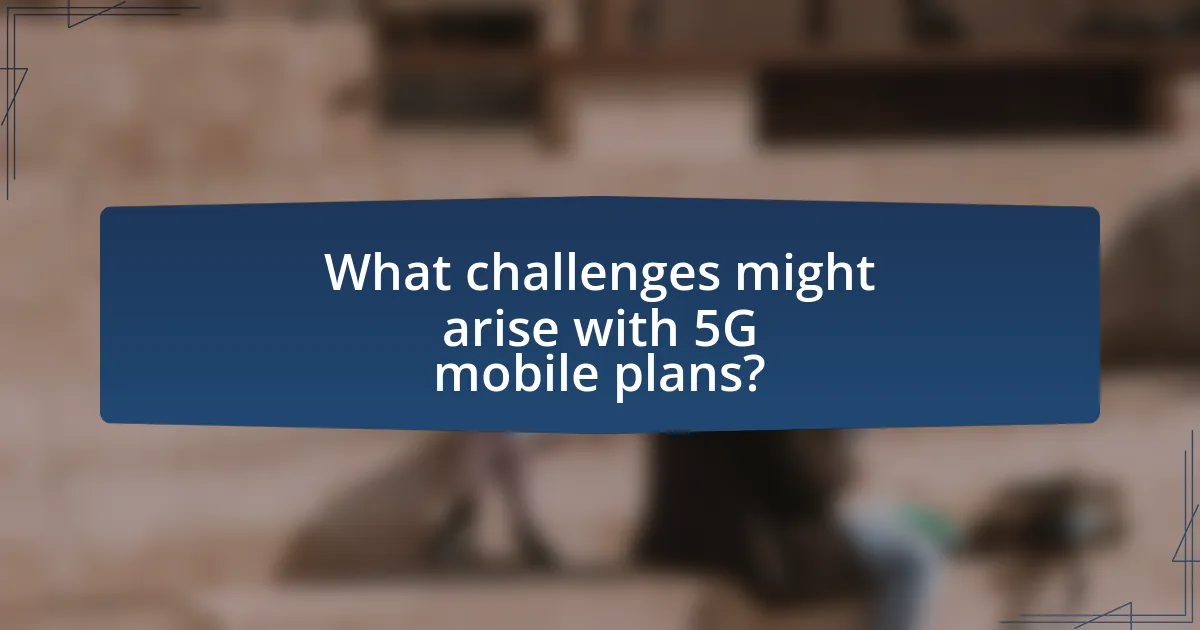
What challenges might arise with 5G mobile plans?
Challenges that might arise with 5G mobile plans include high infrastructure costs, limited coverage, and potential device compatibility issues. The deployment of 5G requires significant investment in new infrastructure, which can lead to increased costs for service providers and, consequently, consumers. Additionally, 5G networks may initially have limited coverage, particularly in rural areas, leading to disparities in access. Furthermore, not all existing devices are compatible with 5G technology, necessitating upgrades or replacements for consumers, which can be an additional financial burden. These factors collectively pose significant challenges to the widespread adoption and implementation of 5G mobile plans.
What are the potential drawbacks of 5G technology?
The potential drawbacks of 5G technology include increased infrastructure costs, limited coverage in rural areas, and potential health concerns related to radiation exposure. The deployment of 5G requires significant investment in new infrastructure, which can lead to higher costs for consumers and service providers. Additionally, 5G networks may not be as widely available in rural regions, exacerbating the digital divide. Concerns about health effects stem from the higher frequency electromagnetic fields used in 5G, although studies, such as those conducted by the International Commission on Non-Ionizing Radiation Protection, indicate that current evidence does not conclusively link 5G exposure to adverse health effects.
How might network congestion affect user experience?
Network congestion significantly degrades user experience by causing slower data speeds, increased latency, and interruptions in service. When many users access the network simultaneously, the available bandwidth becomes limited, leading to delays in loading web pages, buffering during video streaming, and dropped calls in voice services. According to a study by the Federal Communications Commission, congestion can result in a 50% reduction in data speeds during peak usage times, directly impacting user satisfaction and productivity.
What security concerns are associated with 5G networks?
5G networks face several security concerns, primarily due to their increased complexity and reliance on software. One major issue is the potential for cyberattacks, as the expanded attack surface can be exploited by malicious actors. For instance, the use of network slicing in 5G allows multiple virtual networks to operate on a single physical infrastructure, which can lead to vulnerabilities if not properly secured. Additionally, the integration of Internet of Things (IoT) devices within 5G networks raises risks, as many IoT devices have inadequate security measures, making them easy targets for hackers. Furthermore, concerns about data privacy arise, as 5G networks can facilitate the collection and transmission of vast amounts of personal data, increasing the risk of unauthorized access and data breaches. These security challenges highlight the need for robust security protocols and standards to protect 5G networks and their users.
How can consumers prepare for the transition to 5G?
Consumers can prepare for the transition to 5G by upgrading their devices to ensure compatibility with 5G networks. Many smartphones released in 2019 and later support 5G technology, which is essential for accessing the faster speeds and lower latency that 5G offers. Additionally, consumers should review their mobile plans to determine if they include 5G access, as not all existing plans automatically provide this feature. According to the GSMA, as of 2023, over 1 billion 5G connections are expected globally, indicating a significant shift in mobile technology that consumers need to adapt to.
What should users consider when choosing a 5G mobile plan?
Users should consider coverage, data limits, pricing, and device compatibility when choosing a 5G mobile plan. Coverage is crucial as 5G networks are still expanding; users should verify that their area has adequate 5G service. Data limits are important because 5G can consume data quickly; plans with higher data allowances may be necessary for heavy users. Pricing varies significantly among providers, so users should compare costs to find the best value. Lastly, device compatibility is essential, as not all devices support 5G; users must ensure their device can utilize the 5G network effectively.
How can users maximize their 5G experience?
Users can maximize their 5G experience by ensuring they have a compatible device and a suitable mobile plan that supports 5G connectivity. A compatible device is essential because only specific smartphones and gadgets can utilize 5G networks, which offer significantly faster speeds and lower latency compared to 4G. According to a report by the GSMA, 5G networks can deliver speeds up to 100 times faster than 4G, enhancing activities such as streaming, gaming, and video conferencing. Additionally, selecting a mobile plan that provides adequate data allowances and prioritizes 5G access will further enhance the user experience, as many plans may have limitations on data speeds or access to 5G networks.
What are the best practices for selecting a 5G mobile plan?
To select a 5G mobile plan effectively, prioritize coverage, data needs, and pricing. First, assess the coverage maps of different carriers to ensure reliable 5G access in your area, as availability can vary significantly. Next, evaluate your data usage patterns; choose a plan that offers sufficient data to meet your needs without incurring overage fees. Finally, compare pricing and promotional offers among carriers, considering both short-term deals and long-term costs. According to a 2023 report by the Federal Communications Commission, 5G coverage is expanding rapidly, but not all areas are equally served, making coverage a critical factor in plan selection.
